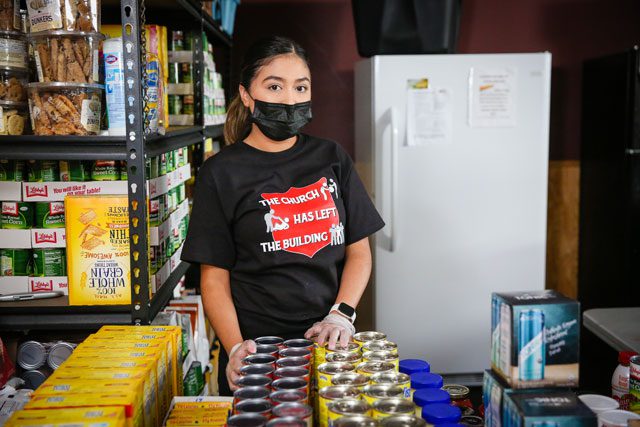by Anne Rochell Konigsmark –
To understand how long Gulf Coast hurricane recovery is going to take, visit this city’s Volunteer Village.
Built beneath the aging bleachers of a high school football field, the “village” houses a volunteer community of strangers from across the country in a collection of small rooms complete with real beds, real showers and air-conditioning.
“We needed a place for the long haul,” says Jim Green of Project Teamwork, a Florida-based volunteer group that runs the camp with The Salvation Army. “Tent cities can only last so long.”
Project Teamwork knows about the long haul. A Volunteer Village constructed in the wake of Hurricane Andrew, which hit South Florida in 1992, remained in operation for a decade. Volunteers, some staying a week, some for months, rebuilt 900 homes in the decimated community of Homestead.
VOLUNTEER VILLAGE:
Haven in a stadium
“And this is 20 times the damage of Andrew,” Green says of the devastation of Hurricane Katrina, which hit 10 months ago.
Katrina rendered uninhabitable more than 65,000 homes along Mississippi’s 70-mile coastline. In Biloxi, the storm destroyed 6,000 homes and businesses, most of them on the city’s poor east side.
Legions of volunteers have been in the region since early September, sleeping on church floors or in tents erected in parking lots. The early days were intense. Hundreds of thousands of suddenly homeless people needed water and food, diapers and toilet paper. Then, mold-covered houses needed cleaning, precious belongings had to be salvaged, and debris hauled away.
This summer, the Gulf Coast is entering the next and longest recovery phase: Rebuilding houses and starting lives anew. Almost a year after the storm, Mississippi’s coast has an eerie emptiness about it. Along the water, where the storm surge lifted floating casino barges and dropped them into neighborhoods, there are far more empty lots and steps leading nowhere than there are homes or businesses. Groups such as Project Teamwork and The Salvation Army plan to be here for many years.
Four days before Katrina hit last August, The Salvation Army bought Biloxi’s Yankie Stadium, with plans to turn it into a Ray and Joan Kroc Community Center of Hope, a $22 million facility named for McDonald’s heiress Joan Kroc.
The 50-year-old concrete bleachers, inundated with about nine feet of water during the storm, were covered in mud and “full of dead things” when Green first saw the structure. It took months to clean it, seal it in and create small rooms under the seats, each holding four bunk beds.
The rooms have been made to look like little houses, “or bayou shacks” as Green likes to call them, complete with shingled roofs, porch lights and fake windows. Each room is air-conditioned; outside, the silver vents pop out of the bleacher seats like mushrooms.
At any given time, the Volunteer Village is home to about 100 people who are refurbishing homes for the poor, the elderly and the working class who reside on the surrounding streets of East Biloxi. They do everything — wiring, plumbing, putting up sheetrock — which means Green is always looking for skilled volunteers.
At lunch, sweaty volunteers — push pins on a map show they’ve come from every state and Canada — gather around long tables for red beans and rice. Green shouts a prayer that sounds more like a football coach’s pre-game pep talk: “Let’s get some breakfast and get these people back in their homes. Amen!”
Tim and Denise Snoddy are having their home rebuilt by village volunteers. Both waiters at casinos before the storm, they say insurance did not come close to covering the immense damage to their modest frame house. “I took care of my mom in there ’til she passed,” says Denise, 50, as she looks through a hollow frame that once held a window. “I home-schooled one of my boys at a kitchen table over there.”
The Snoddys, who say they will return to their jobs when the casinos where they worked reopen, still can’t believe volunteers are rebuilding their gutted home. Last week, a crew began work on a new roof. Eventually, the Snoddys will get new floors, lights, central air and a brand new kitchen. Asked what color she’d like her house painted, Denise’s eyes grow wide. “Oh my God,” she says, “I hadn’t even thought that far ahead.”
The Salvation Army recently announced that it will spend $155 million on long-term recovery projects such as the Snoddy house, in both Mississippi and Louisiana. The money comes from a record-breaking outpouring of donations to the relief organization. The Salvation Army has collected $380 million in hurricane relief, more than four times what it collected after 9/11. There are plans to turn an apartment building in New Orleans into a volunteer village, and build another one in Pass Christian, a nearby Mississippi town.
Other non-profit groups have set up semi-permanent lodging for volunteers: Habitat for Humanity is building a volunteer community next door to the Salvation Army. And in devastated Pass Christian, God’s Katrina Kitchen feeds 1,500 volunteers daily and has a parking lot full of small, air-conditioned sheds with enough beds to sleep 200.
The Salvation Army offers homeowners choices on colors, floor coverings, even appliances.
“One woman began crying when we asked where she wanted her electrical sockets,” Green says. “She said, ‘No one’s ever asked me that before.’”
The volunteers love their comparatively luxurious accommodations. After dinner, they walk to the beach, play soccer on the field, or watch movies on a makeshift screen.
“I walked in and said, ‘This is the coolest,’” says Lisa Chandler, 19, who came with a church group from Pinehurst, N.C. “They made it so cute.” Her friend, Amanda D’Ostroph, 15, agrees: “I just love the village idea. I love our little house.”
—From USA TODAY, a division of Gannett Co., Inc. Reprinted with
permission.












